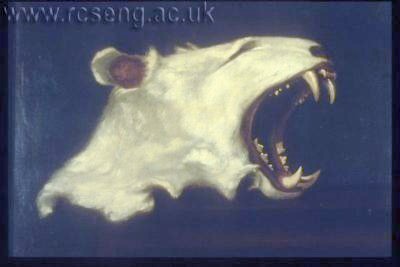
Image copyright Royal College of Surgeons; used in a non-commercial capacity in accordance with Terms & Conditions |
|
STRIPELESS WHITE TIGERS |
Historical quotations are credited and are in the public domain. Original text is licensed under the GFDL. I am grateful to Paul McCarthy, Mary Ann Howell, Catherine Walsh and Jerry Blackman for researching and providing extensive material, information and corrections on white tigers and for genealogies.
“White gene” vs “Inhibitor gene.”
Although these pages refer to “white genes,” white tigers have the genes for normal orange colours, but those genes are switched off by a recessive “inhibitor gene.” When a tiger inherits 2 copies of the inhibitor gene, the normal orange colour is suppressed. In general parlance, it’s simply easier to refer to “white genes.”
Stripeless White Tigers
Pure white tigers are also called snow tigers, ghost tigers (because their stripes show up in certain light) or recessive stripe tigers. They occur when a tiger inherits 2 copies of the recessive white gene + 2 copies of the recessive "wide band" (sometimes called "pale stripe") gene. Because it depends on the levels of 2 proteins that rise and fall during hair growth, the effect of the wide band gene ranges from pale visible stripes to no visible stripes. There are also 2 different reasons a tiger (of any colour) might be described as “stripeless” or “nearly stripeless”, either it has very faint stripes, or it has very sparse striping of a normal colour so that more of the background colour is visible (the opposite of abundism).
An oil painting of an albino tiger head by Robert Home (1752-1834) is on display at the Hunterian Museum, London, UK. It was painted some time between 1790 (Home's arrival in India) and 1807 (when it was presented to the Hunterian Museum, London). The painting was listed in William Clift’s catalogue of museum exhibits of 1816 as "The Head of a White Tyger, which was killed in India; and was by many imagined to have been a Lioness, but in the skin might be perceived the Stripes of the Tyger although very faint, as to be easily overlooked except by very close observation in a proper light. Painted in India by Robert Home." Home's painting shows only the tiger's head. The eye, which might have been diagnostic of either albinism or leucism, has been removed however the nose and lining of the mouth are black, indicating that this is not an albino tiger, but a stripeless white tiger. The skin does not appear to have been preserved as a taxidermy mount or study skin.

Image copyright Royal College of Surgeons; used in a non-commercial capacity in accordance with Terms & Conditions |
A pure white tiger was described in the 1800s as showing ghost stripes: "A wholly white tiger, with the stripe-pattern visible only under reflected light, like the pattern of a white tabby cat, was exhibited in the Exeter Change Menagerie in 1820 and described by Hamilton Smith". Pure white tigers, possibly true albinos, have been documented historically. The 18th century French naturalist Baron Georges Cuvier (1769 - 1832) described the same pure white tigress in his book "Animal Kingdom" "A white variety of Tiger is sometimes seen, with the stripes very opaque, and not to be observed except in certain angles of light. We have engraved from a specimen of this variety, formerly in Exeter 'Change." The 1820 specimen was also described by Rev Woods. Richard Lydekker in "The Royal Natural History" wrote "a white tiger, in which the fur was of a creamy tint, with the usual stripes faintly visible in certain parts, was exhibited at the old menagerie at Exeter Change about the year 1820". This tiger deserves more investigation, particularly as Exeter ‘Change adverts (from 1800 through to 1831) do not mention a white tiger in its collection, nor do any of the travelling mengaeries of the time. There was a well-documented white tiger at the Tower of London menagerie.

In India, Vice-Admiral Sir Edward Pellew, Commander in Chief of the East Indies Station from 1805-1809, acquired a young male white tiger that grew into a tame adult. It was “perfectly white, and the second that has ever been seen in India “. In 1808 Sir Edward had this white tiger on board his flagship the “Culloden” in Bombay harbour. The Sportsman, vol. IV, Jan-June, 1842, printed the account of the dinner (which it had originally printed n 1808): 'To use the homely carpenter's phrase, it is "playing with edged tools" to keep such savage pets, for in ninety-nine cases out of a hundred the owner has to regret some untoward accident. The only exception that I can remember, or indeed ever heard of, was in the instance of Sir Edward Pellew — the Lord Exmouth — who, when he commanded on the Indian station in the year 1808, had a tame tiger on board the Culloden, his flag-ship. It was a large and powerful animal — in fact, a royal tiger to all intents and purposes; but instead of being the usual tan and sandy colour, striped with black, it was white, and the stripes were yellow. This superb animal was the playmate of every soul on board the ship, from the Admiral himself down to the fore-mast man — aye, even unto the loblolly boy. My lamented parents were very intimate with the worthy Admiral, and in the year I write of, my family had availed themselves of an offer from the captain of a frigate which had touched at Columbo, to take a cruise to Bombay. During our short stay at the Presidency, we were frequent guests at Sir Edward Pellew's hospitable table, both on shore and afloat. Having formed an acquaintance with the ship's pet, I was soon on most sociable and friendly terms with this gentle animal, and many a harmless game of romps had I, both on the quarter deck and poop of the flag-ship in Bombay harbour. A startling, and at the same ti me an amusing incident occurred on one occasion, when the worthy Admiral had invited a large party to a tiffin (Anglice, luncheon) on board the Culloden. The guests had scarcely seated themselves around the well-spread table m the Admiral's cabin, and while anticipating a comfortable plate-full of mulligatawny, when, to the astonishment and dismay of all the assembled "convives", as the gallant host was busily employed in the act of dispensing the savoury stimulant, down came the tame tiger, floundering through the skylight overhead, enveloped in a union-jack which had been thrown over the aperture. Souse he came into the tureen; splash went the contents over the Admiral and all those around him. Curry, cutlets, fish, flesh, and fowl—all were overthrown by the struggles of the privileged pet, and the confusion was indescribable. The ladies were not a little alarmed, and some of the gentlemen looked aghast. The dresses of the former, as well as their shawls, were bountifully bespattered with the saffron coloured liquid; and the coats of the latter were not at all improved in appearance by the sprinkling of the various gravies in the surrounding dishes. The officers, midshipmen, quarter-masters, and marines on deck, rushed into the cabin to remove the unwelcome visitor. As soon as this troublesome task had been achieved, the disconcerted Admiral sent to enquire how the accident had been permitted to occur, when the first lieutenant discovered that some of the youngsters—the frolicsome middies—had been enjoying a lark with their playmate on the poop over our heads, and that the tiger in his gambols had leaped on the union-jack instead of clearing the skylight, which had been thrown over it. Two of the principal offenders were sent to the mast-head to do penance for their offence; and when we re-appeared on deck, after discussing the collected fragments of our repast, we saw the originators of this untimely accident sitting most disconsolately on the cross-trees of the fore and main-top-gallant-mast heads. At the earnest request of my good father, the offenders were called down from their elevated position, and after a temperate, and I may say, a good humoured lecture from the benevolent Admiral, were allowed to finish their watch on deck.'

In 1809, Sir Edward made the 6-month voyage back to England, accompanied by his now fully-grown tiger. It was so tame that the crew could regularly trim its claws during the voyage. On arrival, he led the tiger through the Plymouth streets on a small rope, and the children stroked its back without the least danger of being hurt. “Vice-Admiral Sir Edward Pellew, Bart., landed last week from the Culloden a beautiful full-grown hunting tiger. It was so tame that a seaman led it through the streets with a small rope, and the children stroaked it over the back without the least danger of being hurt.” (Royal Cornwall Gazette, 22nd July 1809); “Yesterday was landed from the Culloden, of 74, vice-admiral Sir E. Pellew, and passed at the custom-house, a beautiful hunting male tiger, a present for-some nobleman. Also an elegant tiger cat, which was so tame as to be led to the custom-house, and was actually patted on the back by the children as he passed on, without the usual tiger-like disposition of ferocity.” (Exeter Flying Post, 27th July 1809). There are many other reports of this tiger’s arrival as the story was picked up by newspapers around the country.
“1809 (From Lord Mulgrave, Admiralty, 24 July) Lord Mulgrave has been desired by Vice-Admiral Sir Edward Pellew to mention at a proper opportunity to your Majesty that the Vice-Admiral has brought from India a Royal tiger, perfectly white (the second of that description that has even been seen in India) in the humble hope that your Majesty, in consideration of the extraordinary rarity of the animal, may graciously condescend to receive him as an humble tribute of duty from Sir Edward Pellew.” The King responded (Windsor Castle, 25 July) “The King returns his thanks to Lord Mulgrave for sending him the intelligence received from Rotterdam, and his Majesty desires that Lord Mulgrave will assure Sir Edward Pellew that he is sensible of his attention in bringing from india for him the white tiger which may be sent to the Tower.” (The Later Correspondence of George III 1808-1810 by A Aspinall)
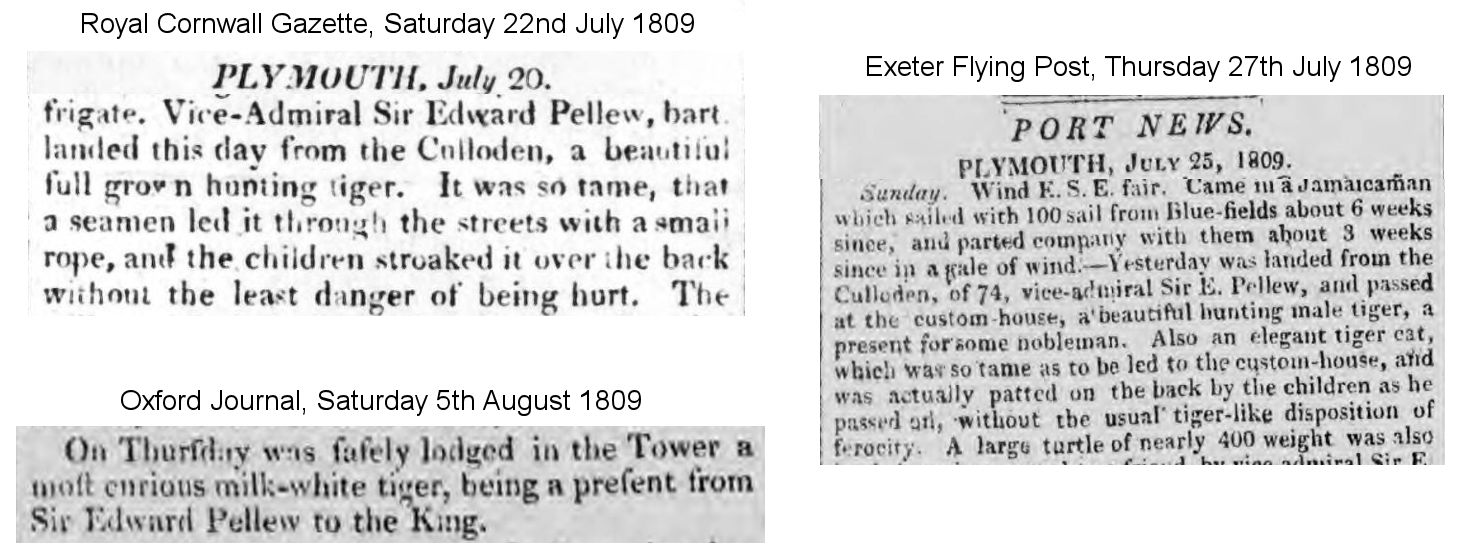
This gift to King George III was mentioned in the Oxford Journal, Saturday 5th August, 1809: “On Thursday [3rd August] was safely lodged in the Tower a most curious milk-white tiger, being a present from Sir Edward Pellew to the King.” This was the Tower Menagerie where the exhibits were confined to cramped cages for public display, and often fed unsuitable diets – the public could gain free entrance by providing cats and dogs to feed to the lions and tigers confined there. The state of the place was described in “Journal of a Tour and Residence in Great Britain, During the Years 1810 and 1811,” by Louis Simond (1815). An entry for May 1811 reads ”the menagerie, which is small, ill-contrived and dirty. The animals look sick and melancholy. The most curious of them was a white tiger, lately brought from India by Sir Edward Pellew, and so tame that the sailors used to pare his claws regularly during the voyage, and on his landing, he was led through some of the streets of London, or rather followed like a dog.” In 1815, the menagerie records there was only a single tigress at the Tower.

In June 1811, Sir Edward sailed from England to take command of the Mediterranean Fleet. In 1814, just before his return to England, his wife Susan wrote him a letter: I hope, dearest ,that you will dispose of your tiger and your wild beasts by the time of your return for remember that they are too expensive to keep had we room, a keeper and no fear, which I confess I have. Nor do I think that I can live in the same house with monkeys, baboons or any others of the race so for pity’s sake dispose of them. We have many pretty grandchildren to amuse you. It’s unlikely that Sir Edward had acquired another tiger, and judging by the date – one month after Louis Simond’s journal entry – Sir Edward had reclaimed his white tiger from the Tower menagerie. Perhaps it had been returned to him due to illness and melancholy. “Your tiger” was referred to as distinct from “your wild beasts” so it seems that Susan Pellew was sharing the house with a very large house-cat. Did Susan dispose of the tiger? If so where to? There is no further mention of it in the press of that time.
A white tiger was reportedly exhibited at the Royal Menagerie at the Exeter Exchange (known colloquially as Exeter ‘Change) in London in or around 1820. At first glance this sounds like Sir Edward’s white tiger, now in its teens. Although it styled itself the “Royal Menagerie,” so did most of the travelling menageries at that time. The real Royal Menagerie, of course, was at the Tower of London (until 1831 when it removed to the Zoological gardens in Regent’s Park). Shore, Wombwell, and Drake all referred to their travelling animal displays as “Royal Menagerie;” so the term probably just meant it contained large, exotic animals. However the numerous adverts in the press make no mention of a white tiger ever being exhibited at Exeter ‘Change. The Exeter ‘Change menagerie changed hands several times (from Mr Pidcock to S. Polito to Mr Clark and then to Mr Cross) a number of times and the live animals were periodically auctioned off, “many of the animals were sold to the itinerant showmen, and who keep such for amusement” (Morning Advertiser, 22nd March 1810). In 1829 the Exeter ‘Change was closed to make way for redevelopment and the animals went first to King’s Mews, Charing Cross (described as a dungeon beneath a watch-house), and then in September 1831 to the Surrey Zoological Gardens. During this time the collection boasted a lion-tiger, a black tiger and Bengal tiger, but never a white tiger (either living or taxidermy). So where did the myth of the Exeter ‘Change white tiger come from? One possible answer to the confusion regarding the Exeter 'Changer white tiger is that Pellew later became Lord Exmouth (1st Viscount Exmouth), and it’s possible that references to “Exmouth’s white tiger” somehow became garbled into “Exeter’s white tiger.”
Edwin Landseer made an engraving of a white tiger, supposedly drawn from the Exeter ‘Change specimen according to authors who used the engraving. He is known to have visited both Exeter ‘Change and the Tower to sketch the big cats, and may well have encountered Pellew’s friendly white tiger at the Tower menagerie. The engraving appeared in Cuvier’s “Animal Kingdom,” (1824) which included the description “A white variety of the tiger is sometimes seen, with the stripes very opaque, and not to be observed except in certain angles of light. We have engraved from a specimen of this variety, formerly in Exeter ‘Change.” Perhaps they confused the two menageries. According to the Leeds Intelligencer, 14th May 1829, a part-work called “The Wonders of the Animal Kingdom” was being published, with illustrations of the “most distinguished Wild Animals now in the various Menageries of this Country; particularly in His Majesty's Collection at Windsor; the Tower of London and Exeter Change; the Gardens of the Zoological Society ; the Private Museums of the Nobility, and the Itinerant Collections of Messrs. Atkins, Wombwell, &c The whole of the Drawings taken from Life, and spiritedly executed by eminent Artists, accompanied by a concise Description the Natural History of each Animal.” Landseer’s white tiger could have been drawn at any of those places.
Pellew had a habit of bringing back animals from his voyages, and his white tiger is mentioned in “Menagerie: The History of Exotic Animals in England” by Caroline Grigson (2016) “However, the only animal of Pellew's recorded at the Tower was a white tiger from India, seen in 1811”
In his "Illustrated Natural History" (1853, 1874) the Rev JG Wood wrote "One of these animals is figured in the engraving; the original was a well known specimen in London about the year 1820. The colour of this animal was a creamy-white, with the ordinary tigerine stripes so faintly marked that they were only visible in certain lights." His book contained an illustration by well-known animal artist Harrison Weir. Wood did not mention where in London it was exhibited.
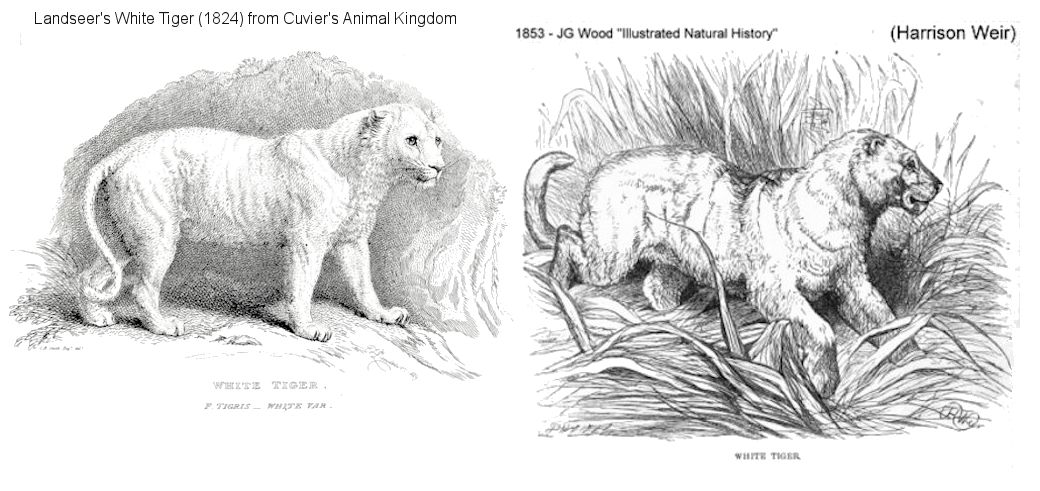
Early 19th century records of wild white tigers were concentrated around NE India, particularly the Assam region south of the eastern Himalayas, including Dibrugarh, Tinsukia, and the Khasi and Jynteah hills of Meghalaya (formerly part of Assam). The white colour is caused by a recessive gene. If all these were stripeless then it meant that 2 recessive genes had become widespread in the region. Perhaps these genes were advantageous to the tigers. Or perhaps a particularly strong white male tiger had sired a disproportionate number of cubs, making the gene more widespread. The natives of Assam believed that whoever killed a white tiger would soon die themselves, but Europeans were not averse to massacring the local tiger population, especially when Assam become commercially important for tea-growing in the mid-1800s. Most information comes from hunters, officials on the tea estates, and naturalists, and is not a comprehensive survey of the population. It’s possible that “common” orange tigers were under-reported. Information also appeared in the monthly Assamese-language journal, the “Orunodai.” This the first Assamese-language newspaper, and was published between 1846 and 1879. It contained a mix of religion, scientific affairs and “general intelligence” (including current affairs).
The Orunodoi, 1851, 6(3), 45 (Reprint Edition, Publication Board, Assam, Guwahati, 1983). contained an illustrated report about the killing of a white tiger in Tinsukia in 1811, and Dibrugarh in 1851. The report is described in an article “White tiger in Assam: earliest authentic record of killing in India “ published in “Current Science” Vol 100, No 2, 25 Jan 2011, Tikendrajit Gogoi (Dept of Zoology, DHSK College, Dibrugarh, Assam): Also, a report exists of the killing of a white tiger in Assam in March 1851. The unnoticed report is a much earlier record of the killing of a white tiger in India. According to The Orunodoi, a white tiger was beaten to death in Dibrugarh District, Assam and its head and skin were brought to ‘Shrijut Doctor Sharlok Sahab’. The fur of the tiger was long and completely white without any spots. The report is also supplemented with a drawing of the tiger (Figure 1). This may be the earliest authentic report of killing of a white tiger in India. … Capturing of a white tiger from Sadiya (District Tinsukia, Assam) during the Ahom [reign of] King Kamaleswar Singha (1795–1811) is also mentioned in the report. “Dr Sharlok Sahab” was possibly Dr Thomas Travers Sherlock, later a surgeon-major in service in Bengal. Gogoi’s article does not distinguish between striped white and stripeless white tigers, but several other tigers from that region were stripeless.
Two "stripeless" (ghost-striped) white tigers were reported by Lt-Col FT Pollok recorded in his book "Wild Sports of Burmah and Assam" (1879): "Mr Shadwell, Assistant Commissioner in the Cossyah and Jyntiah Hills, also had two skins quite white, but when turned about in a strong light just a faint mark or two could be seen to indicate that theybelonged to a tiger at all. The one at E. Ward’s was a splendid skin, very large, but with faint reddish stripes on a white ground. "
In his "Illustrated Natural History" (1853, 1874) the Rev JG Wood Writes: "The colour, too, is more variable than might be supposed, some skins being much darker than others; while occasionally, a specimen is discovered, the fur of which is so pale as the earn the animal the title of White Tiger. One of these animals is figured in the engraving; the original was a well known specimen in London about the year 1820. The colour of this animal was a creamy-white, with the ordinary tigerine stripes so faintly marked that they were only visible in certain lights. It is probably that these White Tigers are only albinos, like the white pheasants, peacocks, corws &c which are so well known, and that they cannot even be ranked as permanent varieties. The markings are of that obscure neutral tint which is seen in the 'eyes' of the albino peacock's tail, and on the feathers of the albino pheasant."
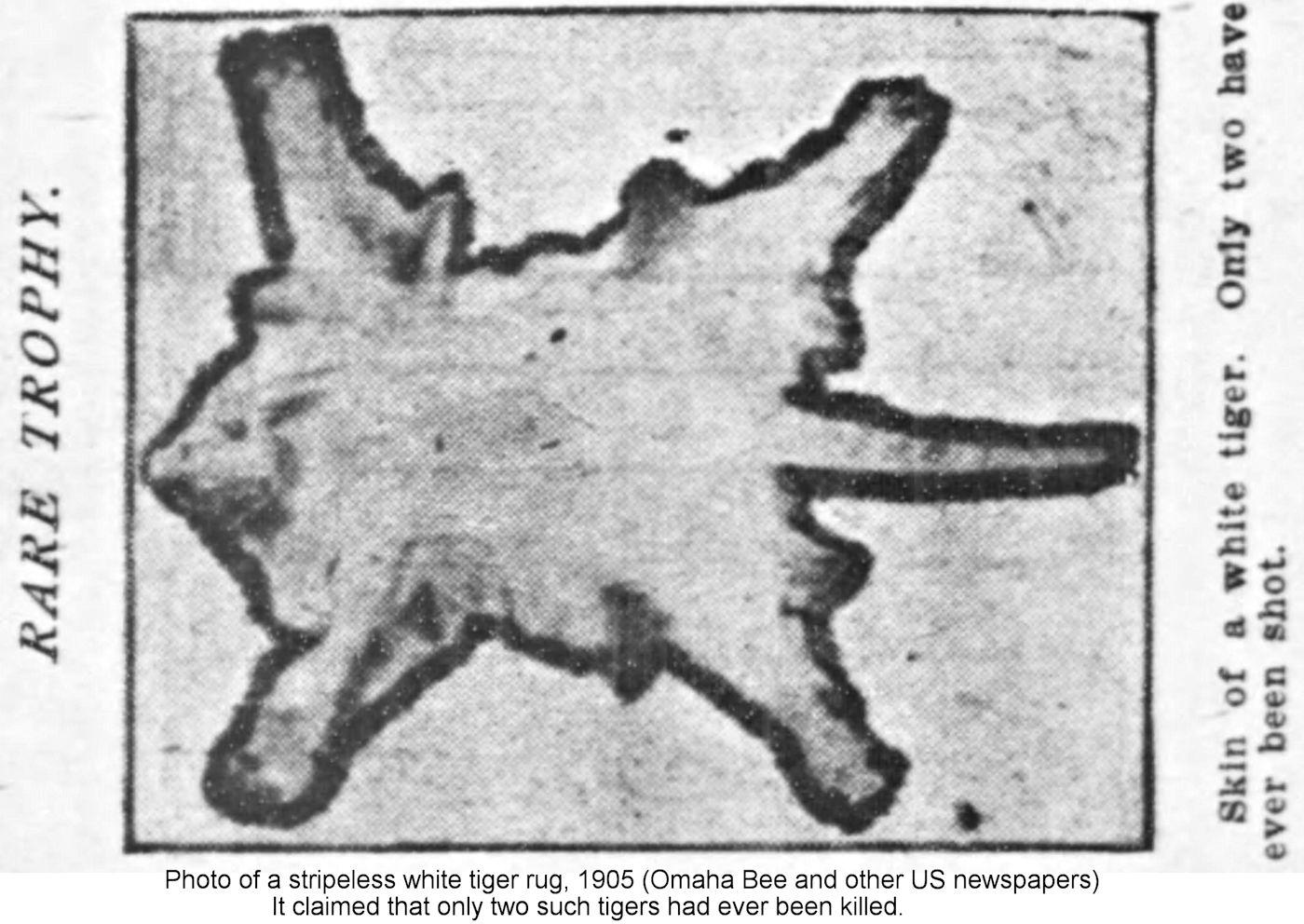
According to the "Bangalore Spectator," 12th August 1885, Times of India, 17th August 1885: Mr. Bassuppajee Urs, I hear, has been informed that a “white tiger,” without any marks about it, has recently been seen in these jungles. How far the animal really answers this description we can, of course, only imagine, as terrified and superstitious natives cannot always be depended upon in such matters. However, the Military Buckshee has resolved to go in search of this strange animal, and if it be really of such an extraordinary appearance, as has been described, to endeavour to capture it alive, and send it to the Menagerie, at Bangalore, in the name of His Highness the Maharajah.
The skin of a tiger killed in 1891 was displayed at a meeting of the Zoological Society of London., The “Proceedings of the Zoological Society of London”, June 1891, p372 tell us: Mr Howard Saunders, FZS, exhibited and made remarks on a nearly white skin of a Tiger from Northern India. The animal had been sent for preservation to Messrs Keilich and Son by Major D Robinson, Lancashire Fuseliers, Poona. From the skull and the condition of the teeth it appeared to be an adult male in the prime of life, the incisors being sharp and perfect. Col HH Godwin-Austen FZS, remarked that in his long experience in India he had only met with one similar example.
Further details were given in an article in the Shoreditch Observer, 11th July 1891 (and in many other papers): A white tiger is indeed a great rarity. Nevertheless, at the last meeting of the Zoological Society, Mr. Howard Saunders exhibited the skin of an adult male animal which had been shot by Major D. Robinson, of the Lancashire Fusiliers, at Poona. Major Godwin Austin, who spoke on the subject, mentioned his having killed one on the Khasia Hills, and alluded to another as having been shewn at the society’s meetings many years ago. It is not said whether these were albinos, like our pure white cat - a good example of the carnivorous type. In the ordinary tiger the ground tint is of a rich brown or tawny hue, with deep black cross stripes. Major Robinson’s skin was remarkable in that the ground tint was whitish grey (in this resembling the snow leopard), with very faint brownish cross stripes, not solid as in the ordinary tiger, but each split in the back joining towards the belly. No case of a black tiger is recorded, though black leopards are not uncommon, several specimens having been alive at the “Zoo.”
J. Hampden Porter, writing about white tigers in “Wild Beasts” 1894 stated: “In the Himalayas [tigers] have been shot at an elevation of eight thousand feet above the sea, and, besides being what is called white, were maned.” This presumably referred to the heavy neck ruff developed by some mature males.
Mid Sussex Times, 18th April 1899 (and many other papers) provide an account of a white tiger shot in 1899: A white tiger has recently been shot in Assam by Hr. W. H. Greenish, manager of the Naharkutia tea estate in Upper Assam, and the skin sent to Mr. Newing, Calcutta taxidermist. Mr. Newing has given the following particulars to the ‘Calcutta Englishman’: “Under process of curing, in which stage it is at present, the skin measures 9ft. 6in. from the nose to the tip of the tail, but completion of the process, another 10 in. will be added to its present length. The colour of the skin is a beautiful white, while the stripes, though not very clearly indicated at present, establish its identity as a genuine tiger skin, even did its length fail to bear out that belief. When the skin is properly cured and dried, the marks will show quite distinctly."
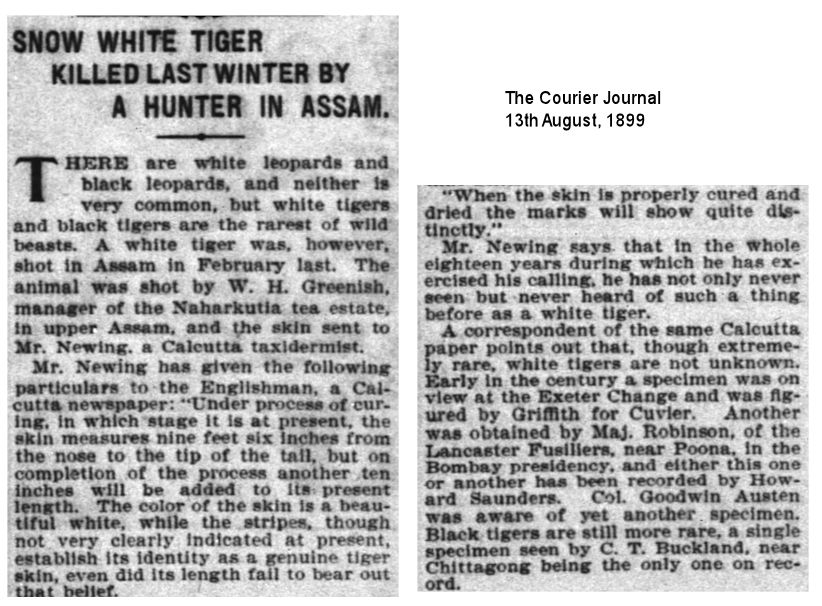
Lydekker describes this skin in his book, “The Game Animals of India, Burma, Malaya and Tibet” (1907) along with an illustration: “in March 1899 a white tiger was shot in Upper Assam and the skin sent to Calcutta . . . the property of Mr W J Consadine, Major HDC Swayne wrote as follows: The colour of the skin is like that of a polar bear, with the faintest lines to indicate stripes. The ground-colour is bright creamy white , exactly like a polar bear, the darker lines representing stripes, are about the dull white of a rather dirty white cat which has been out all night on the roof.”
Edward Pritchard Gee, a tea planter and naturalist who lived much of his life in India, wrote articles about wildlife for the Journal of the Bombay Natural History Society. In the article “Albinism and Partial Albinism in Tigers” he described 2 white tigers from Assam circa 1900: “Boga Bagh tea estate in Upper Assam is so called from the two white tigers found there at the beginning of this century, and one of them had ‘a lemon-coloured patch on the back of the neck, otherwise it was white with faint stripes’.
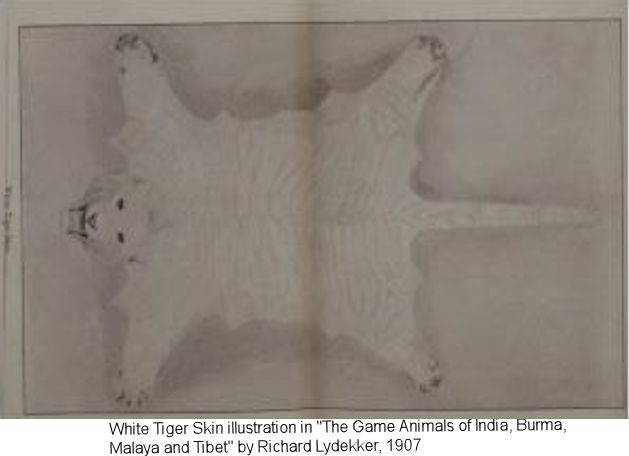
Several British newspaper of 7th August 1908 reported the killing of a snow-white tiger in Assam. A WHITE TIGER. From a French source we learn that a beautiful white tiger has been killed in Assam, and that in due course it will placed in the Museum at Calcutta. The animal was found in this way. Two native hunters came across some white hair, from which they concluded there had been fight between two animals. Proceeding, they found a dead buffalo, and short distance away, stretched the grass, a great animal of nowy whiteness. A well-directed shot killed the beast, and on getting at close quarters it was found to magnificent white tiger. (Dundee Evening Telegraph, 27th Aug 1908 and also THE FIRST WHITE TIGER. Two old and intrepid native hunters have killed in Assam, says the Indian “Pioneer,” what is believed to be the first known specimen of a white tiger. They had been out after buffalo on elephants, and came across traces of a struggle between a wild boar and a tiger. White hairs which lay on the ground aroused their curiosity. They followed the tricks and found the boar dead. A few yards away they caught a glimpse of a large white animal, at which they fired. It disappeared in long grass, but the carcase was found two days later, and proved to that of a well-grown tiger. The skin has been sent to the Calcutta Museum. (Belfast Weekly News, 13th Aug 1908)
While those might have been very pale chinchilla mutants or blue-eyed albinos, the pink-eyed white tigers shot in Cooch Behar, north-east India, in 1922 were evidently pure albinos. A normal-coloured tigress and her four cubs were shot; two of the cubs were tawny tigers, but the other two were white with pink eyes (true albinos) and relatively long necks (probably due to inbreeding). This was reported as a Miscellaneous Note in the Journal of the Bombay Natural History Society. Victor N. Narayan wrote "We sent our head Jemadar to reconnoitre and he came face to face with 4 tigers, 2 of which he reported as being of a very light colour. Three days later we shot 4 tigers out of the same jungle . . . We thought we had bagged all the tigers, but on examination found that two were full-grown cubs, and two about three-quarters grown. The two full-grown cubs, were of the ordinary colour and markings of a tiger, 1 male and 1 female. Measurements about 6’6". The three-quarters grown cubs, were unique and to me seemed pure albinos. They had pink eyes and were evidently in very bad condition because before being shot at they only trotted along like big dogs, whilst the other two galloped hard. Another peculiarity was the long neck, quite unlike that of any other tiger or leopard I have ever seen; one was a male and one a female. As it was dark we could not beat any more but two days later got the mother, a fine beast in the prime of life and condition. Measurement 8’9". I forgot to mention the measurement of the freaks viz. 6’0". Such beasts have never been known of, or seen here, nor during the many shooting excursions my father (the late Maharaja Uripendra of Cooch Behar) made into Assam."
There is a newspaper clipping from 1924 describing an almost stripless white tiger: “Calcutta, June 9. Sportsmen all over India are greatly interested in the skin of a white tiger recently shot by the Maharaja of Sirguja and which is now on display here. Except for a few dark stripings the pelt is almost pure white and measures nine feet eight inches from nose to tail tip. The white tiger is extremely rare, but few specimens ever having been secured, and this one is reported to have had a career of depredation that included three human victims and innumerable cattle. According to reports from the district in which it was killed, the beast actually appeared to use its unusual coloration as an aid to hunting. It was continually mistaken for a steer or cow as it lay quietly among the herds waiting a chance to kill, and the natives assert that it mixed freely with the herds without exciting alarm. Three instances are related of the tiger having been seen lying quietly in the jungle and being mistaken by natives for a beast it had slain and in each of these cases when the native approached, he was killed. “
Another stripeless white tiger was photographed in Similipal Reserve, Orissa, India in 1989. True pink-eyed albino tigers are disadvantaged by their conspicuousness, photo-sensitive eyes and lack of skin pigment (they risk skin cancer). There are currently no true albino tigers in captivity. In India in captivity, no stripeless white tigers appear to have ever been born.
Note: Because ghost-striped white tigers were recorded in the NE India tiger population, especially in Assam, the ghost-striping gene was present and would almost certainly have produced golden tigers as well because the wide-band (stripeless) gene is inherited separately from the white gene. Wild golden tabby tigers (which are described on a separate page) are hard to find in the historical records. They may be recorded as erythristic tigers or red tigers. In Assam, in 1929, two light-coloured red tigers, which we would now call golden tabby tigers, were shot. According to the Van Ingen brothers who provided a photograph to the JBNHS: “The red tigress in the foreground was shot some years ago in Assam by the late Mr W G Forbes. The skin was white with the pale tan background and marked with fine stripes in a darker shade of tan. Curiously the three last stripes at the tip of the tail were black.” “Variation in Colour of Tigers and Panthers” by Van Ingen & Van Ingen, in JBNHS v.42:pt.3-4 (1942). J.C.Daniel provided further information on the skins in his 2001 book “The Tiger in India” that the two light-coloured tigers shot by W.G. Forbes of Hathikuli Tea estate in 1929 were described at the time of curing by Messrs. Van Ingen as ‘red tigers’.
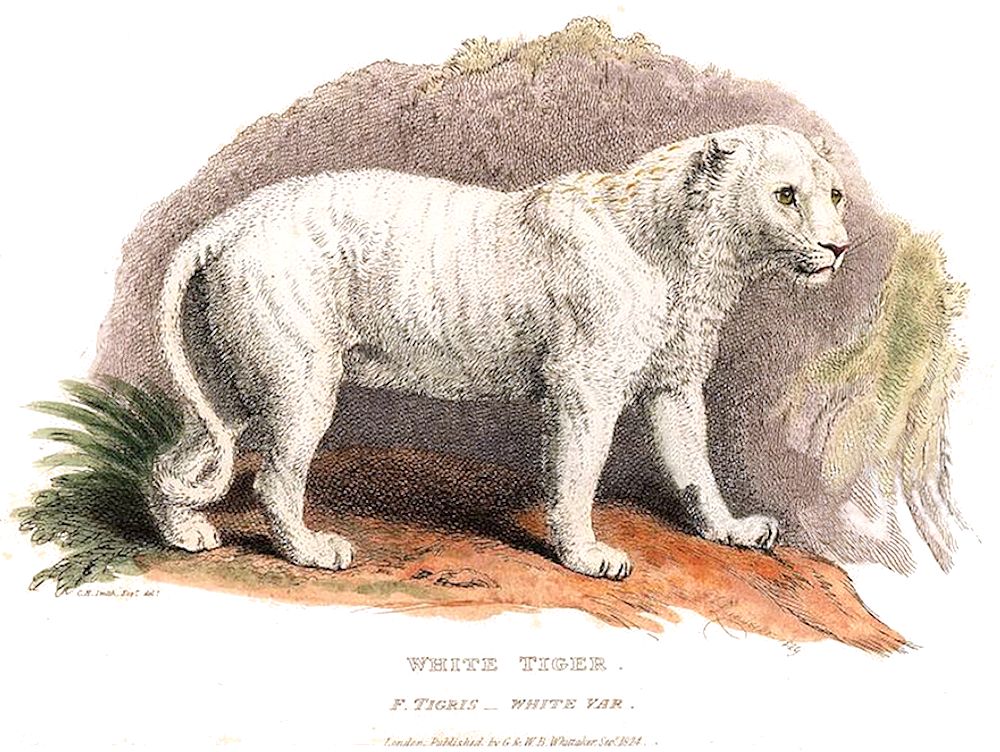
SNOW WHITE TIGERS IN CAPTIVITY
Captive stripeless white tigers appeared in the American white tiger population as a result of mating white tigers Bhim and Sumita at Cincinnati Zoo. Mating their stripeless descendants to normal orange tigers also resulted in golden tabby tigers further down the line. Bhim and Sumita were inbred and traced to 4 foundation tigers: Mohan and Begum (Rewa white tigers), Susie and Kubla. Susie was an orange circus Bengal tiger from Sioux Falls, descended from Mohan x Begum via one of their early orange cubs traded through an animal dealer. Kubla was an Amur tiger from wild parents.
The studbook shows that Mohan and Begum’s other descendants did not produce stripeless tigers or golden tabby tigers. There is a theory that Susie came from wild-born parents, possibly captured by animal collector Peter Ryhiner in Assam in the 1950s, to obtain elephants and Indian Rhino. He also obtained tigers and tiger cubs which were sold to Animal Dealer Zeehandelaar (Florida), who sold them to Circuses and Zoos. (Ryhiner, Peter and Mannix, Daniel P; “The Wildest Game,” Cassell London, 1959. The News Tribune, Fort Pierce, Florida, 11th May 1954; Argus-Leader, Sioux Falls, South Dakota, 14th September 1955). This is very tenous and there is better information from within the circus tiger community showing Susie to be a descendent of Mohan and Begum. Baron Julius von Uhl, John F. Cuneo Jr., Rhys Walkley (who compiled many genealogies) and Wade Burck all knew Susie to be a descendant of Mohan (In a game show called “Beyond Reason” in Canada, some time after 1976, Wade Burck said there were two unrelated strains of white tigers and that his white tigers were a mixture of both. Burck has since said to correspondents that this was incorrect.).
The Ryhiner theory may hinge on a news report in The News Tribune, Fort Pierce, Florida, 11th May 1954 that in 1954 Ryhiner shipped a consignment, including “2 tame tigers,” to North Atlantic Fertilizer and Chemical Co Inc (NAF&C Co), New York, one of the largest importers of wild animals. The Wild Animal Compound, Vero Beach, Florida was their storage base and affiliated corporation. The president of the Compound was animal importer Frederick J. Zeehandelaar. It was opened in December 1954 and, although open to the public, it was primarily an animal storage depot for service to circuses and zoos. An inventory, published in Billboard on April 7, 1956, included two tame/gentle female Royal Bengal Tigers aged 1.5 years and 3 years (these seem likely to be transfers between zoos/circuses rather than wild imports.)
Mohan had several litters with Begum (producing only heterozygotes). No white tigers were being allowed out of India at that time, but several of the orange offspring were sold to the animal dealers P.M. Das and Sons, Calcutta. All descendants of Mohan prior to 1959 are accounted for in the Leipzig Zoo Bengal tiger studbook. This records a heterozygous male born in 1953 and a heterozygous orange female from their 1955 litter that were sold to animal dealers lost to follow-up (“LTF”). Two other heterozygous offspring (1953 male, 1955 female) went to the same animal dealer. Clyde Beatty wanted white tigers, but there was an export ban on these. If he knew that Mohan’s orange offspring were easily available, he could have bought heterozygous orange tigers from P.M. Das, knowing that he could inbreed them to get white tigers. Although the paper trail is missing, the dates strongly indicate that Susie is the offspring of one or more of the orange heterozygotes traded by P.M. Das. The verbal evidence indicates that her ancestry was known within the tiger training community and according to the New Delhi Zoo, Tony, her white grandson, was a descendant of Mohan.
Susie carried the white gene and possibly the pale-stripe gene. If not, the pale striping might have been a spontaneous mutation in her daughter, Kesari (some genes are prone to mutation due to their position on the chromosome, while different [novel] mutations can have the same visible effect).
According to the Minneapolis Star, 10th September 1955, Kubla’s parents were wild-born Amur tigers from Manchuria, Northern China. There are old records of white tigers in China, anecdotal accounts from Siberia, and an unconfirmed sighting of a white tiger in Manchuria in the 1930s, however the white skins from China were described as black-striped. (Taylor, Mary Linley: “History of White Tigers in the Wild, & “The Tiger’s Claw: The exploits of George Yankovsky, East Asia’s Mighty Hunter,” London, Burke, 1956.) An outside possibility is that the Amur tiger had the pale-stripe gene, but this is based on the fact that it is closely related to the Caspian tiger, and that the Caspian tiger produced the “red tiger” (possibly golden tabby) described by Pocock. It is a tenuous link given that Pocock’s red tiger was found in NE India - a long way from Manchuria.
Because the wide-band gene has a variable effect, many stripeless tigershave a degree of ghost striping. For example, Artico (Spain) and a litter of white tigers in Liberic, Czech Republic are described as stripeless, but have more pronounced stripes than Mohan at Dream World. At the other extreme, there was a very stripeless tiger in Spain that came from Japan.
In the 1980s, Cincinnati Zoo was the first and only zoo having stripeless white cubs (then believed sterile). In 2004 a blue-eyed, stripeless white tiger was born at a wildlife refuge in Alicante, Spain. Its parents are normal orange Bengal tigers and the cub, named Artico (Spanish for Arctic), is not an albino, but a white tiger similar to that described by Cuvier and Hamilton Smith. Although white tigers are relatively common in zoos, there are only about 20 stripeless white tigers around the world. Artico was not announced to the world until August 2004, when he was 3 months old. At birth he was so weak he seemed unlikely to survive and he still needs special care as he cannot digest food properly.
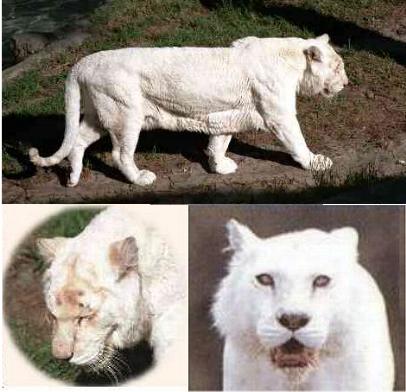
Liberec zoo in the Czech Republic had a litter of three white cubs born, two of which were stripeless. They acquired white tigers in August 1994 from Eskilstuna Parken Zoo in Sweden, which got them in 1989 from Chicago, from "one of the largest breeders of white tigers" (possibly Cuneo or Cincinnati Zoo). Siegfried and Roy obtained a snow white female called Sitarra from Cincinnati Zoo. Roy chose 2 striped cubs – costing a small fortune – and persuaded the zoo to let him have the stripeless female cub, which the zoo believed would be sterile. The zoo also agreed that Roy could take any stripeless cub born in the future. For details of the Siegfried & Roy tigers see:
Circus White Tigers: Siegfried and Roy's Tigers
Chart S: Siegfried and Roy's White Tigers (large image, opens in new window)
The New Delhi Zoo loaned out white tigers to various zoos in India for outcrossing, and the government had to impose a whip to force zoos to return either the white tigers or their orange offspring. In the mid 1980s Siegfried & Roy offered to collaborate with the Indian government in the creation of a healthier strain of white tigers. The Indian government was reportedly studying the offer. However, Siegfried & Roy’s tigers were not pure Bengal tigers and were not suitable for conservation purposes.
Longleat had a stripeless white tiger with a severe case of sway back, it was featured on Jack Hanna's TV show when he visited Longleat.
A Spanish zoo had a stripeless white tiger from Japan, apparently born at a circus. Three offspring of Bhim and Sumita had been sent from Cincinnati Zoo to Japan: Shirotan (male), Shirorin (female) and snow white Snow Queen (female).
In December 2008, news reports claimed a stripeless white tiger, Fareeda, was born "in the wild". In fact Fareeda and 2 littermates were born in captivity at Cango Wildlife Ranch, near Cape Town, South Africa, where white tigers are bred. Fareeda was born to two white Bengal tigers and has 2 striped littermates, Shahir (m) and Sitarah (f). Fareeda was hand-reared. The Wildlife Park claims to want to return the species to the wild (white tigers aren't a species, just a "breed") which makes it a pity they don't concentrate on normal orange Bengal tigers - Fareeda's stripelessness indicates both severe inbreeding and pollution with Siberian tiger genes.
Textual content is licensed under the GFDL.
FOOTNOTE
Most white tiger websites have a pro- or anti-agenda and variously claim to give “facts,” “truths” or debunk “myths” but give misinformation or have hidden agendas. I stick to facts and deductions based on facts. Some information is documented, some is from personal correspondence with zoos, and some is from the recollections or personal notes of people involved with circus or zoo tigers where records were have been lost or destroyed. Even the different editions of tiger studbooks are inconsistent. Information from my pages, which are frequently updated, is widely copied on those other sites. Some sites have tried to claim I copied their work.
|
BACK TO HYBRID & MUTANT BIG CATS INDEX |